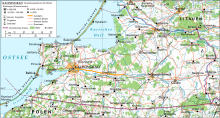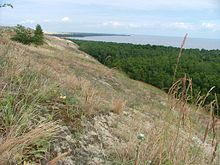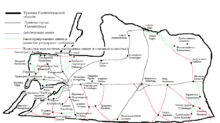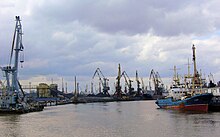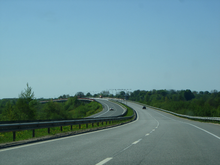Kaliningrad Oblast
|
Subject of the Russian Federation
Kaliningrad Oblast
Калининградская область
|
||||||||||||||||||||||||||||||||||||
Coordinates: 54 ° 48 ' N , 21 ° 9' E
The Kaliningrad Oblast ( Russian Калининградская область Kaliningradskaja Oblast ), also called Kaliningrad Oblast , is the westernmost oblast (Russian region ) of the Russian Federation . It is one of the smallest federal subjects and at the same time the smallest oblast in Russia. The oblast has almost 942,000 inhabitants (2010) and with an area of 15,125 km² is somewhat smaller than Schleswig-Holstein . In Russia, the area is often referred to as the Amber Land (Russian Янтарный Край / Jantarny Krai ), which indicates its wealth in amber .
The capital is Kaliningrad , the former Königsberg . The area of the oblast covers roughly the northern third of the former East Prussia (i.e. the former area of the province without the Lithuanian Memelland and the Polish areas of Warmia , Mazury and Oberland ). As an exclave - apart from being accessible via the free international Baltic Sea - the oblast is surrounded by Lithuania and Poland. Belarus and Latvia are still located between Lithuania and the further eastern heartland , so that the land connection from the heartland to the oblast leads through two foreign states.
The area plays an important role for Russia for its Baltic Fleet with headquarters in Baltiysk .
geography
Limits
The Kaliningrad Oblast is bounded in the west by the Baltic Sea , by the Memel in the north, the Šešupė , Širvinta and Lipowka in the east of Lithuania (the border section along the last three rivers has existed since the 13th century and is one of the longest unchanged existing borders of Europe). In the south, the oblast borders on Warmia-Masuria in Poland . This border runs almost dead straight from the Fresh Spit north of Krynica Morska (Kahlberg) to the east to the southern tip of the Wystiter See .
landscape
The landscape is of slightly wavy plains with glacial hills , mostly quilted meadows and fields as well as much forest determines that of wide river plains is interrupted and marshes. The largest rivers are the Pregel and Memel , other rivers are the Lawa (Alle) , the Angrapa (Angerapp) , the Krasnaja (Rominte) and the Dejma (Deime) . In the north of the oblast - bordering the Curonian Lagoon - there is the elk lowland (Losinaja Dolina) and the Großer Moosbruch , a moorland that has been partially drained, but increasingly swamped again due to lack of care. In the southeast lies the Rominter Heide with the Wystiter See and the Wystiter Hügelland , which form the highest elevation in the oblast at up to 230 m. In the west, the Samland juts out into the Baltic Sea as a peninsula . In the southwest lies the Fresh Lagoon . The oblast is part of the Curonian Spit and the Fresh Spit .
politics
The acting governor of the oblast has been Anton Alichanov since October 2016 . In the Oblast Duma (regional parliament) there are the same political forces as in the Russian Duma . The strongest force is the presidential camp. The main political issues are high unemployment and social / health issues such as the spread of diseases such as AIDS and tuberculosis . Added to this are the economic problems associated with the exclave situation. Other major difficulties arise from the high level of organized crime and corruption in the administration. The military continues to play a strong political role .
In the course of the international financial and economic crisis , which hit Russia hard, the oblast developed into a stronghold of the Russian opposition. Unlike in the Russian heartland, where oppositional rallies are often nipped in the bud and only attract a few people, several thousand people took part in individual rallies. The particularly critical attitude of many Kaliningraders towards the Moscow central power and the regional government appointed by it is, among other things. a. attributed to the special situation of the oblast (see also section “ exclave status ”) . Many citizens have already visited the neighboring EU states Poland and Lithuania and compare the economic and political development there with the situation in their home country.
Area Duma elections
2011
The elections for the 5th legislative period of the Kaliningrad Regional Duma took place on March 13, 2011. The turnout was 42%. 4.22% of the votes were declared invalid. The valid votes produced the following result.
| Political party | percent | mandates directly |
List of mandates |
Total mandates |
|---|---|---|---|---|
| United Russia | 42.6% | 15th | 9 | 24 |
| KPRF | 22.3% | 1 | 5 | 6th |
| LDPR | 13.1% | - | 2 | 2 |
| Just Russia | 10.5% | - | 2 | 2 |
| Patriots of Russia | 8.9% | - | 2 | 2 |
| Yabloko | 2.5% | - | - | - |
| Independent | - | 4th | - | 4th |
| total | 99.9% | 20th | 20th | 40 |
Marina Orgeeva (United Russia) was elected chairman of the Regional Duma.
Nikolai Vlassenko (United Russia) was sent to the Russian Federation Council as a representative of the Regional Duma.
2016
The elections for the 6th legislative period of the Kaliningrad Regional Duma took place on September 18, 2016. The turnout was 42.9%. 3.78% of the votes were declared invalid. The valid votes produced the following result.
| Political party | percent | mandates directly |
List of mandates |
Total mandates |
|---|---|---|---|---|
| United Russia | 42.8% | 19th | 10 | 29 |
| LDPR | 17.3% | - | 4th | 4th |
| KPRF | 17.3% | - | 4th | 4th |
| Just Russia | 7.3% | - | 1 | 1 |
| Patriots of Russia | 6.2% | - | 1 | 1 |
| Yabloko | 3.5% | - | - | - |
| RPP | 3.4% | - | - | - |
| Rodina | 2.2% | - | - | - |
| Independent | - | 1 | - | 1 |
| total | 100.0% | 20th | 20th | 40 |
Marina Orgeeva (United Russia) was re-elected chairman of the Regional Duma.
MP Alexei Korotkow (United Russia) was sent to the Russian Federation Council as a representative of the Regional Duma. He resigned from the Duma, which thus reduced to 39 members.
Exclave status
Since the oblast has no connection with mainland Russia, specific problems arise. These mainly concern traffic between the exclave and the rest of Russia (see section “Traffic”) and the economy. There is a large gap in prosperity with its EU neighbors Poland and Lithuania, to whom restrictive customs and border restrictions exist. The Russian domestic market is difficult to access for products from the oblast, as an expensive and lengthy transit through other countries, including Lithuania and Belarus, is necessary. The shabby infrastructure, excessive bureaucracy and the region's high level of militarization (see sections “ Economy ” and “ History - 1990s to today ”) are also obstacles to further development .
Administrative divisions and cities
The oblast is divided into 15 Rajons and seven urban districts . The largest city and the only major city in the oblast is its administrative center Kaliningrad , the former Königsberg . There are a total of 22 cities and two urban-type settlements in the oblast .
| Surname | Russian | Residents (October 14, 2010) |
|---|---|---|
| Kaliningrad (Koenigsberg) | Калининград | 431.902 |
| Sovetsk (Tilsit) | Советск | 41,705 |
| Chernyakhovsk (Insterburg) | Черняховск | 40,449 |
| Baltiysk (Pillau) | Балтийск | 32,697 |
| Gussew (Gumbinnen) | Гусев | 28,260 |
| Swetly (room shack) | Светлый | 21,375 |
population
The last Russian censuses in 2002 and 2010 showed a population of 955,281 and 941,873 residents, respectively. The number of inhabitants thus fell by 13,408 people (−1.4%) in these eight years. Kaliningrad thus has a significantly more favorable demographic development than Lithuania and Latvia, for example, which recorded population declines in the double-digit percentage range. According to official data, the population of the Kaliningrad Region grew again and rose to 976,439 by 2016, which is a historical high.
The distribution of the different ethnic groups was as follows:
| nationality | VZ 2002 | percent | VZ 2010 | percent |
|---|---|---|---|---|
| Russians | 786.885 | 83.14 | 772.534 | 86.43 |
| Ukrainians | 47,229 | 4.99 | 32,771 | 3.67 |
| Belarusians | 50,748 | 5.36 | 32,497 | 3.64 |
| Lithuanians | 13,937 | 1.47 | 9,769 | 1.09 |
| Armenians | 8,415 | 0.89 | 9.226 | 1.03 |
| German | 8,340 | 0.88 | 7,349 | 0.82 |
| Tatars | 4,729 | 0.50 | 4,534 | 0.51 |
| Residents | 955.281 | 100.00 | 941.873 | 100.00 |
Note: the proportions refer to the total number of people who provided information on their ethnicity
The Russian Germans are almost exclusively relatively new immigrants from other Russian regions and not East Prussians who have remained resident. In 1959, fewer than 700 Germans lived in the entire Kaliningrad region. Even today, around 50% of the population were not born in the oblast; Especially after the collapse of the Soviet Union, many Russians immigrated from the former republics. The military is an important factor: 14,500 members of the armed forces live in the oblast.
languages
People living in Kaliningrad Oblast speak the following languages:
| language | VZ 2010 |
|---|---|
| Russian | 95.85% |
| English | 7.53% |
| German | 3.01% |
| Ukrainian | 1.86% |
| Belarusian | 0.88% |
| Lithuanian | 0.87% |
| Polish | 0.74% |
| Armenian | 0.62% |
| Others | 2.18% |
0.07% or 648 Kaliningraders also knew Russian sign language .
religion
As in most of Russia, the Russian Orthodox faith is most widespread in Kaliningrad Oblast .
The Catholic minority belongs to the West Region of the Archdiocese of Moscow . Municipalities exist in Bagrationowsk ( Prussian Eylau ), Baltijsk ( Pillau ), Bolschakowo ( Groß Skaisgirren ), Gwardeisk ( Tapiau ), Gussew ( Gumbinnen ), Jantarny ( Palmnicken ), Kaliningrad ( Königsberg ), Krasnosnamensk ( Lasdehnen ), Lipki ( Lenkimmen ), Mamonowo ( Heiligenbeil ), Neman ( Ragnit ), Nesterow ( Stallupönen ), Osjorsk ( Darkehmen ), Otwaschnoje ( Wickbold ), Pionerski ( Neukuhren ), Polessk ( Labiau ), Rasdolnoje ( Pohren ), Zalessje ( Mehlauken ), Selenogradsk ( Cranzlauken ), Slavsk ( Heinrichswalde ), Snamensk ( Wehlau ), Sowetsk ( Tilsit ), Swetly ( room shack ) and Tschernjachowsk ( Insterburg ).
The Evangelical Lutheran Church of European Russia, which belongs to the Kaliningrad provost , has 38 parishes, many of which are Russian- Germans. The Kaliningrad Provosty is the largest in Russia.
Healthcare
The spread of hepatitis B , hepatitis C , HIV and tuberculosis is becoming a growing problem in the region . Some hospitals in the area capital have some modern equipment thanks to the help of some domestic or foreign sponsors. However, there is a marked shortage of sterile disposable items, especially in the Rajons hospitals. It is widely reported that the Kaliningrad region is the most affected area in Russia by the spread of AIDS. However, it must be taken into account that the only reasonably complete record of infected people is in this area in Russia.
Other demographic information
There are 267,220 private households in Kaliningrad Oblast with an average of 3.1 people. Children and young people under the age of 18 live in 19.8% of households. 65.9% of households are family households of spouses. Children and young people under the age of 18 live in 44.1% of them. 65.1% of households with children are one-child households. In 29.5% there are two children, in 5.4% there are three children or more.
54.8% of the adult Kaliningrad population is married and cohabiting with their spouse, 8.8% are divorced , and 1.5% are separated from their spouses. 20.3% of Kaliningraders of legal age are single and 11.0% are widowed .
26.6% of Kaliningrad adults have a university degree. 47.3% have a high school diploma after 11 years of school (university entrance qualification). 13.4% have a middle school diploma after 9 years of school. 7.8% only have basic education after 5 school years. 0.5% did not attend school.
economy
The Kaliningrad Oblast is still of great importance for Russia as a military base (closed until 1991) and because of its ice-free Baltic ports . The establishment of a special economic zone “ Jantar ” shows only hesitant success, which is blamed in particular on the strong isolation of the area, the ruling bureaucracy, the high crime rate and the corruption that is often encountered. Kaliningrad has a large fishing fleet (the largest in Russia), as well as car assemblies for BMW and KIA . The economy suffers from the isolation of the area from its neighbors and the state borders to be overcome with the Russian heartland. Great hopes are placed in the discovery of oil in the Baltic Sea. Large parts of the rural population work in mostly cooperative agriculture and - on the coast - in fishing. A lot of agriculture is done here for self-sufficiency. Since 2010, the Kaliningrad nuclear power plant has been under construction as the first nuclear power plant in the Oblast near Neman on the Memel. The nuclear power plant is intended both to compensate for the electricity deficit after the shutdown of the Lithuanian nuclear power plant in Ignalina and to generate exportable electricity. However, the Russian energy minister announced in November 2015 that construction work would not resume in the foreseeable future. As a reason he gave changed economic conditions.
tourism
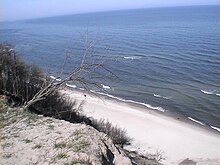
Tourism in the Kaliningrad Oblast developed by leaps and bounds after the opening of the former military restricted area, since many former residents of northern East Prussia visited the region around the former Königsberg (Prussia) as homesick tourists . After a short time, however, this wave of visitors subsided. Of great and ebbing of the homesickness tourism of increasing importance in the coastal resort towns Zelenogradsk and Svetlogorsk and on the Curonian Spit in domestic tourism. One reason for this is the excessive bureaucracy and the visa requirement for EU citizens, which, however, was lifted by a government resolution with effect from July 1, 2019 with a free e-visa valid for up to eight days. For the first time since the end of the Second World War, German citizens would then be able to reside in the oblast, at least temporarily, free of charge.
The newly built villas near the beach, which wealthy Muscovites build in these places, testify to the growing domestic tourism. Kaliningrad itself has only a few historical sights after severe destruction during the war, including the old Königsberg Cathedral and some old city fortifications. However, the city is important as a local transport hub and shopping city. In most of the area there is hardly any tourist infrastructure, especially not for individual tourism. The local tourist authority tries to develop various types of tourism such as hunting tourism , equestrian tourism and rural tourism as well as to promote tourism in small and medium-sized towns such as Sovetsk (Tilsit) . Rail cruises to the area are also popular .
traffic
Maritime transport
In 2015, the port of Kaliningrad handled 12.7 million tons. This makes it the fourth largest Russian Baltic port.
Domestic traffic
There is a wide-meshed, 645 km long railway network within the oblast, 95 km of which are electrified (routes from Kaliningrad (Königsberg) to Svetlogorsk (Rauschen) and Zelenogradsk (Cranz) ). In addition, a large part of the traffic is handled by buses . Kaliningrad is connected to the Lithuanian border at Chernyshevskoye (Eydtkuhnen) by the developed A 229 trunk road . The route to Poland is the route of the R516 motorway ( Elbing - Königsberg ) , which was only operated with two lanes (one lane) before 1945 , which was recently opened to traffic again, but is now only one road of regional importance. The length of the road network is 6714 km. This means that after Moscow Oblast and the Kabardino-Balkaria Republic , the Oblast has the third densest road network of the Russian Federation subjects (excluding the cities of Moscow and Saint Petersburg; 438 km per 1000 km² at the end of 2009). At the end of 2009 the first section of the Samland motorway was opened. The 27 km long four-lane section connects Kaliningrad with Zelenogradsk and connects directly to Khrabrovo Airport. The second, 24 km long section of the planned ring road is to connect Zelenogradsk with Svetlogorsk. In the final stage, this should extend to Baltijsk (Pillau) .
With the rest of Russia
Most of the traffic flows from the oblast go to the Russian heartland in the form of transit connections through Lithuania and Belarus . However, due to the situation as an exclave surrounded by foreign countries requiring a visa, traffic with the rest of Russia is very difficult, which is a serious problem for the local economy. Only half of the inhabitants of the area even have a passport and are thus able to apply for a visa (which is very expensive for the average Kaliningrader).
railroad
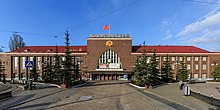
The most important mode of transport from the Kaliningrad Oblast to the Russian heartland is the railroad . Tickets for transit trains to the Russian heartland must be purchased at least one day before the trip, as a so-called transit document (de facto a transit visa ) is required. These trains run through to the Russian heartland without getting on or off.
The rail network of the Kaliningrad Oblast is operated by Kaliningradskaja schelesnaja doroga , a branch of the Russian State Railways ( RŽD ). At the time of the Deutsche Reichsbahn, there were 1,823 km of railway lines in northern East Prussia, in 2010 it was 963 km.
In the oblast there are statistically 409 kilometers of rail on 10,000 km² (as of the end of 2009), which puts it in second place after the Moscow Oblast (with the city of Moscow) in a comparison of federal subjects. However, due to the high level of motorization (4th place in Russia), the use of rail in passenger and freight transport is becoming less important.
Street
The main road connection to Moscow runs through the border crossing Chernyshevskoye - Marijampolė - Vilnius - Minsk - Smolensk , the main road to Saint Petersburg runs through the border crossing Sovetsk (Tilsit) - Šiauliai - Riga - Pskov . Russians need transit visas for both routes.
ferry
There is a visa-free ferry connection from Baltijsk (Pillau) to Saint Petersburg , which takes 48 hours for one direction in 2018 and on which ice-resistant car ferries are used. Fast ferries are planned for rail, car and passenger transport, which will only need 15 hours and will run from the new ferry terminal near Baltiysk to Ust-Luga near Saint Petersburg. A boat trip costs as much as the train journey via Lithuania and Belarus . The problem was that in the past the ferry failed frequently and over long periods of time. The reasons given were mostly technical problems.
plane
To the north of the city of Kaliningrad, near Khrabrovo (Powunden), there is the international airport Kaliningrad-Khrabrovo , from which there are also visa-free domestic flights to the Russian heartland several times a day.
With the neighboring countries
There are four road border crossings to Poland, four road border crossings to Lithuania (one of which is only for citizens of Lithuania and Russia) and two rail border crossings each to Poland and Lithuania (one each exclusively for freight traffic).
From Chrabrowo Airport (Powunden) there will be connections in 2018 mainly with
- Aeroflot to Moscow
- Belavia to Minsk
- Polskie line Lotnicze (LOT) to Warsaw
- Pulkovo Aviation to Saint Petersburg
- SAS Scandinavian Airlines to Copenhagen
- UTair to Moscow
Since Poland and Lithuania joined the EU, residents of the oblast need a visa for all neighboring countries . In connection with very restrictive border controls, this has meant that the so-called small border traffic has practically come to a standstill since then and the oblast is more oriented towards the Russian heartland than before.
Since August 1, 2012, citizens of the oblast who have lived there for at least three years have been allowed to enter a 50-kilometer-wide strip near the border to Poland for ninety days every six months without a visa. This means that you can only travel to Masuria , the cities of Elbląg , Olsztyn , Braniewo (Braunsberg) and Gołdap (Goldap) with a Propusk (pass) from the Polish Consulate General in Kaliningrad . On the coast they are allowed to travel to Gdańsk (Danzig), Sopot (Sopot) and Gdynia (Gdynia) and as far as the Hel Peninsula. Conversely, residents of the Polish areas concerned can travel to the entire Kaliningrad Oblast without a visa.
history
Until 1945
For the history before 1945 and the expulsion of the East Prussians see under East Prussia .
Repopulation
After East Prussia had been conquered by the Red Army at the end of the Second World War in May 1945 , the Soviet government formed the Kenigsbergskaja oblast as part of the Russian SFSR from the Osobnij wojennij okrug ( Special Military Okrug ), which had existed since July 1945, on April 7, 1946 . Already on July 4, 1946, the new naming Kaliningrad and Kaliningradskaja oblast ("Kaliningrad region") took place. The German-language newspaper Neue Zeit appeared from 1947 to 1948 until the German population was finally expelled . At the same time, campaigns were running throughout the Soviet Union, with a focus on central Russia , the area of today's Volga Federal District , northeastern Ukraine , and in Belarus to repopulate the areas depopulated by the war and the expulsion of the native German population. In addition to members of the garrisons located here, people who had lost their home village or their families in the war, but also soldiers returning home, returnees released from German prisoner-of-war prisoners who feared punishment for alleged collaboration with the enemy, and prisoners who had been committed came into the country were to settle in this region. The area became a restricted military area, which even Soviet citizens could only enter with a special permit. Around 2280 places were not settled again and have not existed since then, the other 2520 places received new Russian names, most of which no longer had any reference to the old place names ( e.g. Schelesnodoroschny (railway town) for Gerdauen, Matrossowo (sailor village ) for Gilge, Slavsk ( glorious place) for Heinrichswalde). In some cases, groups from neighboring villages were given a common new name. New names were given for the other larger cities, e.g. B. Zelenogradsk (Green City) for Cranz or Sovetsk (City of the Council system) for Tilsit.
1960s to perestroika
In 1969, despite protests from residents, the ruins of the Königsberg Castle were blown up and the construction of the still unfinished council house next to its former location was started. After that and in the 1970s, the old buildings were increasingly torn down and many cities, including the capital, were rebuilt. Since the area of the oblast was closed to Soviet citizens until 1969 and could only be visited with a special permit, it developed very slowly. The entire region was a military restricted area and also housed nuclear weapons. Swamping turned out to be a major problem for agriculture in many areas, as these regions had been drained by complex drainage systems before the Second World War. These systems were not maintained after the war and were often wantonly destroyed as heavy agricultural machines, which were not suitable for the management of this area, to the newly established collective farms and state farms were used. This problem affected the moose lowland , for example .
Opening of the area
Until 1990, the Kaliningrad Oblast, as part of the former German eastern territories, was viewed by the Federal Republic of Germany - but not by the GDR - as being under Soviet administration under international law , even if the Supreme Soviet of the USSR had already approved the area with ice-free access to the Baltic Sea on May 17. It was annexed in October 1945 and by decree on April 7, 1946 it was incorporated into the RSFSR as the "Königsberg area" . With the ratification of the Moscow Treaty of August 12, 1970, the Federal Republic of Germany declared the existing borders inviolable and expressly waived the assertion of territorial claims. This waiver was reaffirmed in the two-plus-four contract of September 12, 1990. The affiliation of the Königsberg area to Russia was no longer up for discussion.
In 1991 the area was reopened to foreign visitors as part of perestroika . Among other things, many “homesick tourists” came to the Oblast temporarily, which has been part of the Russian Federation since the dissolution of the Soviet Union . With the political opening, the building fabric was reinforced. This applies to some representative churches such as the Königsberg Cathedral and some village churches, but also other isolated buildings such as the Königin-Luise-Brücke (see section “Culture”) .
1990s until today
With the dissolution of the Soviet Union and the independence of the Baltic states, the new situation arose that the oblast had become an exclave separated from Russia and became dependent on imports. There were early plans to make Kaliningrad a Hong Kong on the Baltic Sea. The Jantar (Bernstein) special economic zone was set up for this purpose, but it was not very successful. With the accession of Lithuania and Poland to the EU as part of the EU enlargement in 2004 , the exclave situation worsened, since a visa has de facto been required to travel from the oblast to the Russian heartland. Since homesick tourism in the tourism sector has largely subsided in the 1990s, attempts are being made to develop a new clientele, mainly from Russia and Belarus. Since March 29, 2004, the oblast has been completely surrounded by NATO territory on the land side .
Efforts among the population for greater autonomy from Russia are increasing, the Baltic Republican Party is striving to establish a “Fourth Baltic Republic” within the EU , which is associated with Russia, under the name of Baltia . In 2002, then party chairman Sergei Pasko estimated those in favor of breaking away from the Russian Federation in the oblast at around 10 percent. On March 26, 2003, the BRP's status as a party was revoked under Russian law.
In autumn 2010, a movement was formed in Kaliningrad Oblast to simplify visa regulations with the EU. As a result, the Russian government became aware of the mood in the region and took economic and political measures. Support for industry, agriculture and tourism was increased and the infrastructure expanded. In addition, the prices for train tickets and flights have been reduced. The Russian police arrested and fired several pro-European officers in 2014. Most of the pro-European residents left the region, mostly for EU countries.
Functionaries
Party secretaries of the WKP (B) / KPdSU 1947–1991
- 1947: Pyotr Andrejewitsch Ivanov (Пётр Андреевич Иванов) [in the position of 2nd secretary]
- 1947–1951: Vladimir Vasilyevich Shcherbakov (Владимир Васильевич Щербаков)
- 1951–1959: Wassili Jefimowitsch Tschernyschow (Василий Ефимович Чернышёв)
- 1959–1961: Fyodor Wassiljewitsch Markow (Фёдор Васильевич Марков)
- 1961–1984: Nikolai Semjonowitsch Konovalov (Николай Семёнович Коновалов)
- 1984–1989: Dmitri Wassiljewitsch Romanin (Дмитрий Васильевич Романин)
- 1989–1991: Yuri Nikolajewitsch Semjonow (Юрий Николаевич Семёнов)
Chair 1946–1991
- 1946–1948: Wassili Andrejewitsch Borissow (Василий Андреевич Борисов)
- 1948–1951: Alexei Andrejewitsch Jegorow (Алексей Андреевич Егоров)
- 1951–1962: Sachar Filippowitsch Slaikowski (Захар Филиппович Слайковский)
- 1962–1966: Jakow Andrejewitsch Pruschinski (Яков Андреевич Прушинский)
- 1966–1983: Wladimir Nikolajewitsch Witkowski (Владимир Николаевич Витковский)
- 1983–1987: Wassili Andrejewitsch Loginow (Василий Андреевич Логинов)
- 1987–1991: Yuri Alexandrowitsch Malinkin (Юрий Александрович Малинкин)
Governors (since 1991)
| In office since | Name ( German transcription and in Cyrillic ) |
|---|---|
| September 25, 1991 | Yuri Semjonowitsch Matotschkin (Ю́рий Семёнович Ма́точкин) |
| 5th November 1996 | Leonid Petrovich Gorbenko (Леонид Петрович Горбенко) |
| December 7, 2000 | Vladimir Grigoryevich Yegorov (Влади́мир Григо́рьевич Его́ров) |
| September 28, 2005 | Georgi Walentinowitsch Boos (Гео́ргий Валенти́нович Боо́с) |
| September 28, 2010 | Nikolai Nikolajewitsch Zukanow (Николай Николаевич Цуканов) |
| July 28, 2016 | Yevgeny Nikolayevich Sinitschew (Евгений Николаевич Зиничев) |
| October 6, 2016 | Anton Andreevich Alichanow (Антон Андреевич Алиханов) |
Strategic importance
The Russian armed forces maintain various bases in the Kaliningrad Oblast, including the main base of the Baltic fleet in Baltijsk and radar stations. In response to the missile defense shield sought by the United States , Russia began modernizing the Pionersky radar station and incorporating it into its own missile defense system. In addition, the radar closes the gap in Russian reconnaissance caused by the closure of the facilities in Ukraine and Lithuania.
Culture
In Kaliningrad there is the regional drama theater, a nationally known puppet theater, a music theater, a philharmonic orchestra, various other theaters and galleries, an annual film festival and a German-Russian house with regular cultural events. There is also a theater in Sovetsk. There are also various museums in smaller towns (mostly local museums). Today, the Kaliningrad Oblast maintains partnerships at government level with the German states of Brandenburg and Schleswig-Holstein , which in addition to an economic component also includes cultural cooperation.
Traditions and identity
After the conquest of the area of today's Oblast, the traces of the earlier, long-term German history were deliberately destroyed. This particularly affected castles, country estates and churches. The former north-east Prussia was only to be a restricted military area. This changed with perestroika . Since then, the earlier story has not been concealed any more, and some organizations such as church congregations and hospitals from this area maintain partnerships with former residents of East Prussia, which is reflected in some aid transports to this region.
Today's oblast is clearly a Russian area and, from an official point of view, sees itself culturally as the western outpost of Russia. Officials are endeavoring to construct a new identity based on Russian history in the Baltic Sea region, but also with partial consideration of the region's earlier history. This often creates the impression of a misunderstanding of history . The oblast is thus placed in the tradition of Russian history in the Baltic States - that is why one often encounters references to the "Russian Baltic" in this region. In the Kaliningrad Oblast, for example, the tradition of opening to the west is emphasized under Tsar Peter the Great , who had made frequent trips to Königsberg. The short episode during the Seven Years' War between 1758 and 1762, in which the area under Tsarina Elisabeth had already been annexed by Russia (“first Russian episode”), gains in importance in this context. An element from the pre-Russian period that is occasionally referred to is the fact that settlers from many areas ( Salzburg , Switzerland , the Netherlands ) settled in the former East Prussia , just as today's population comes from various regions of the former Soviet Union . It is concealed that a substantial part of the East Prussians descended from the Prussians, who had lived for thousands of years . It is also often emphasized that Königsberg was a Hanseatic city with many contacts to Russia ( Novgorod ) and that there was a university rich in tradition here , from which many influences came to Russia.
The Königsberg philosopher Immanuel Kant is seen as a figure of identification : The Pregelinsel in Kaliningrad , which was formerly called Kneiphof Island and later simply called the “Island”, was renamed to “Kant Island”. There were even proposals to rename the former city of Koenigsberg and today's city of Kaliningrad "Kantgrad". Old brick Gothic village churches are being prepared for Russian Orthodox services in some places , and some churches are or have been newly built in the traditional Russian style. The Russian Orthodox Diocese of Kaliningrad and Baltiysk exists in the region of the Oblast . Castles and mansions are partly being renovated where they still stand and where money is available. One of the efforts to create a Russian identity of its own is the introduction of new sovereign badges for the region, which are not modeled on earlier Prussian symbols and only refer to Russian symbols - this applies in particular to the monogram of Tsarina Elisabeth, which appears in the coat of arms and flag the time of the Seven Years' War, when the area was already Russian.
Awards
- Order of Lenin , awarded on April 14, 1966 "for making advances in the development of the national economy"
See also
literature
- Stefan Berger (Ed.): Kaliningrad in Europe. Neighborhood Perspectives after the End of the Cold War. (= Publications of the Nordost-Institut , Volume 14). Harrassowitz, Wiesbaden 2010, ISBN 978-3-447-06163-6 .
- Hanne-Margret Birckenbach : Kaliningrad - a European pilot region? The perspective of peace and conflict research . In: Mirror of Research. 23 (2006) issue 1/2, pp. 32–40, full text (PDF, free of charge, 32 pages, 381 kB.)
- Christian Bülow: Economic and socio-geographic regional analysis of the Russian Kaliningrad Oblast. Der Andere Verlag, Uelvebüll 2011, ISBN 978-3-86247-167-6 .
- Christian Papendick : The north of East Prussia - land between disintegration and hope. Documentation 1992-2007. Husum Verlag, Husum 2009, ISBN 978-3-89876-232-8 .
Web links
Individual evidence
- ↑ Administrativno-territorialʹnoe delenie po subʺektam Rossijskoj Federacii na 1 janvarja 2010 goda (administrative-territorial division according to subjects of the Russian Federation as of January 1, 2010). ( Download from the website of the Federal Service for State Statistics of the Russian Federation)
- ↑ a b Itogi Vserossijskoj perepisi naselenija 2010 goda. Kaliningradskaya oblastʹ. (Results of the 2010 all-Russian census. Kaliningrad Oblast.) Volume 1 , Table 4 (Download from the website of the Kaliningrad Oblast Territorial Organ of the Federal Service for State Statistics of the Russian Federation)
- ↑ Nacional'nyj sostav naselenija po sub "ektam Rossijskoj Federacii. (XLS) In: Itogi Vserossijskoj perepisi naselenija 2010 goda. Rosstat, accessed on June 30, 2016 (Russian, ethnic composition of the population according to federal subjects , results of the 2010 census).
- ↑ NEWSru.com: Митинг оппозиции в Калининграде, по подсчетам Немцова, собрал три тысячи человек
- ↑ Königsberger Allgemeine, April 2011.
- ↑ Official website of the Duma ( Memento of the original from January 12, 2012 in the Internet Archive ) Info: The archive link was inserted automatically and has not yet been checked. Please check the original and archive link according to the instructions and then remove this notice.
- ↑ Information on www.kaliningrad.vybory.izbirkom.ru
- ↑ List of elected officials on http://duma39.ru/
- ↑ Igor Petrovich Rudnikow
- ↑ http://www.gks.ru/free_doc/new_site/population/demo/Popul2016.xls
- ↑ http://demoscope.ru/weekly/ssp/rus_nac_59.php?reg=29
- ↑ http://kaliningrad.gks.ru/wps/wcm/connect/rosstat_ts/kaliningrad/resources/ed6bab004c8c9d74acf7bf915ce0328a/%2Fvpn2010%2F2010%2Fpril_6.htm
- ↑ http://kaliningrad.gks.ru/wps/wcm/connect/rosstat_ts/kaliningrad/resources/b0a3c8804c8beb84a2a6bb915ce0328a/%2Fvpn2010%2F2010%2Fpril_4_1.htm
- ↑ http://kaliningrad.gks.ru/wps/wcm/connect/rosstat_ts/kaliningrad/resources/f8f201004c8c0d54be45bf915ce0328a/%2Fvpn2010%2F2010%2Fpril_3.htm
- ↑ http://kaliningrad.gks.ru/wps/wcm/connect/rosstat_ts/kaliningrad/resources/0d555d004c8c079bb98ebb915ce0328a/%2Fvpn2010%2F2010%2Fpril_7.htm
- ^ Electricity for Europe: Start of construction for a nuclear power plant in Kaliningrad - "Vedomosti" at RIA Novosti , February 25, 2010.
- ↑ Kaliningrad will not receive a nuclear power plant . Retrieved December 14, 2015.
- ↑ Foreign Office: Foreign Office - Electronic Visa for the Kaliningrad Region. Retrieved June 28, 2019 .
- ↑ Regional Tourism Authority (English and Russian) ( Memento from December 20, 2008 in the Internet Archive )
- ↑ Администрация морских портов Балтийского моря. Retrieved May 2, 2016 .
- ^ Regiony Rossii. Social ʹ no-ėkonomičeskie pokazateli. 2010 . Rosstat, Moscow 2010, ISBN 978-5-89476-310-1 , p. 676 ( regions of Russia. Socio-economic indicators. 2010 ; Russian).
- ^ Preußische Allgemeine Zeitung / episode 02-10 of January 16, 2010
- ↑ Route network almost halved since 1945 , Preussische Allgemeine Zeitung / episode 06-10 of February 13, 2010
- ^ Regiony Rossii. Social ʹ no-ėkonomičeskie pokazateli. 2010 . Rosstat, Moscow 2010, ISBN 978-5-89476-310-1 , p. 674 ( regions of Russia. Socio-economic indicators. 2010 ; Russian).
- ^ Regiony Rossii. Social ʹ no-ėkonomičeskie pokazateli. 2010 . Rosstat, Moscow 2010, ISBN 978-5-89476-310-1 , p. 34 ( regions of Russia. Socio-economic indicators. 2010 ; Russian).
- ↑ Kaliningrad: Visa-free border traffic has opened , report in "Russland-Aktuell" (Russia News) from August 1, 2012.
- ↑ Ukas of the Presidium of the Supreme Soviet of April 7, 1946 (Russian)
- ↑ Ukas of the Presidium of the Supreme Soviet of July 4, 1946 (Russian)
- ↑ http://www.welt.de/print-welt/article383765/ “The West is at the door” , report in “Die Welt” from April 12, 2002.
- ↑ But Moscow took the idea so seriously that in 2003 it had the activity of the "Separatist Party" prohibited by a court order.
- ↑ http://newsbalt.ru/analytics/2012/10/bezuslovno-nelzya-isklyuchat-silovo/
- ↑ https://klops.ru/news/ekonomika/155958-pod-zelenogradskom-otkrylsya-pererabatyvayuschiy-kompleks-selskohozyaystvennoy-produktsii?e_id=2203
- ↑ http://www.interfax-russia.ru/NorthWest/news.asp?id=817199&sec=1679
- ↑ https://gov39.ru/news/101/110852/
- ↑ http://345mz.ru/ru/news/n574.html
- ↑ https://ria.ru/economy/20161226/1484669152.html
- ↑ sdelanounas.ru
- ↑ http://www.vedomosti.ru/newspaper/articles/2012/08/08/kaliningrad_blizhe
- ↑ shttps: //rg.ru/2016/11/15/reg-szfo/v-2017-godu-vyrastut-subsidii-na-lgotnye-polety-v-kaliningrad.html
- ↑ http://vesti-kaliningrad.ru/pravda-o-nko-zelenogradsk-pinneberg-eksklyuziv/
- ↑ https://www.novayagazeta.ru/articles/2010/08/04/2168-imenem-rashida-gumarovicha
- ↑ Russia - Three New Voronezh Radars In 2013 ( Memento of December 18, 2013 in the Internet Archive ), notification of January 9, 2013.
- ↑ http://www.defencetalk.com/new-russian-radar-to-be-tested-near-kaliningrad-34205/
- ↑ printed in the Административно-территориальное деление Калининградской области 1975 (The administrative-territorial division of the Kaliningrad 1975 published by Soviet of Kaliningrad, page 5) to http://www.soldat.ru/ (rar file).





